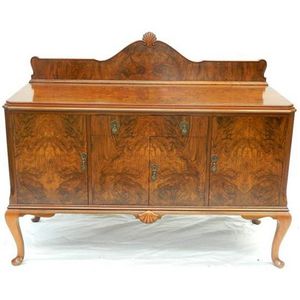18th Century Austrian Walnut Commode and Hutch
You must be a subscriber, and be logged in to view price and dealer details.
Subscribe Now to view actual auction price for this item
When you subscribe, you have the option of setting the currency in which to display prices to $Au, $US, $NZ or Stg.
- Hutch - A term without a strict definition, but generally used to describe a food or storage cupboard with doors in the top section, standing on legs with shelves below.
- Provenance - A term used to describe the provable history of an antique or work of art, and thus an additional aid to verifying its authenticity. Provenance can have an inflating effect on the price of an item, particularly if the provenance relates to the early settlement of Australia, a famous person, or royalty. Less significant are previous sales of the item through an auction house or dealer.
- Circa - A Latin term meaning 'about', often used in the antique trade to give an approximate date for the piece, usually considered to be five years on either side of the circa year. Thus, circa 1900 means the piece was made about 1900, probably between 1895 and 1905. The expression is sometimes abbreviated to c.1900.
- Commode - The word "commode" when used to describe an item of furniture, has three usuages:
1. As used to describe an item of English furniture, it refers to what is euphemistically called a 'night table', that is a small cabinet concealing a chamber pot.
2. In its 18th century French usuage it describes a low and highly decorated chest of drawers for salons and reception rooms. A bombe commode is a commode with rounded sides and front, giving the chest a somewhat swollen look.
3. It is also used to denote a half round or serpentine shaped cabinet, with panelled doors, standing on legs. They were pieces on which the cabinetmaker lavished his most accomplished art, with rich veneers, marquetry inlays, gilt mounts and other ornamentation.
This item has been included into following indexes:
Visually similar items

A fine quality George III flame mahogany bookcase secretaire, the top with two panel glazed doors, arch to the top of each, stepped pediment, enclosing three fitted shelves, the base with four front secretaire enclosing a fitted quality interior with drawe

A burr walnut four door one drawer sideboard by Beard Watson, Sydney, circa 1930, with key, 125 x 149 x 60 cm

A large 18th century English oak mule chest, the front with four deep pointed arched panels, the base with three drawers, shaped apron and raised on stile feet, pegged joints, brass handle and key escutcheon. 143 x 50 x 104 cm

A vintage bird's eye maple corner cabinet, mid 20th century, the cabinet having an arched architectural pediment with a six panelled astragal glazed door, with chamfered edges, an extended base with a quarter veneer panelled cupboard and raised on shaped b
